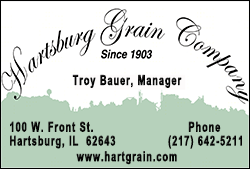|
 Throughout the week, walking the Midway, one will see families
munching on fair food, or standing in line for the grandstand show.
There will be teenagers, hanging together as a group, snapping
selfies they will tag “me and my buds at the fair.” There will be
old farmers gathered around the antique tractors talking about the
“good ol’ days.” Throughout the week, walking the Midway, one will see families
munching on fair food, or standing in line for the grandstand show.
There will be teenagers, hanging together as a group, snapping
selfies they will tag “me and my buds at the fair.” There will be
old farmers gathered around the antique tractors talking about the
“good ol’ days.”
In the exhibit barns, there will be kids proudly pointing out their
blue ribbons to grandma and grandpa, an award they won as a result
of participating in a 4-H judging.
In the livestock barns, parents stand on the sidelines, anxiously
waiting and trying to hear what the judges say to their children
about the animal they are showing. For those who are unfamiliar with
the processes, some of the sights can appear strange or downright
comical. Watching a kid try to put a bunny on its back, or seeing a
judge looking at the hinny of a chicken, just seems strange.
Watching a 100-pound youngster manhandling a 1,000-pound steer with
nothing but a rope and a stick, pulling, poking and prodding until
the animal somewhat willingly walks in a circle before a judge, may
seem pointless. Equally comical can be the chaos of kids chasing
hogs around an arena, trying to get them to take their noses out of
a fence corner, or walk at a reasonable pace past a judge, may seem
like an exercise in futility.
 Though these things may seem pointless, for the 4-H youngster, his
or her parents and the judges, this brings to an end a long period
of work and study by the kids. Preparing for the fair is not
something the kids do a week before hand. For many, it involves
months and months of preparation. When they stand before the judge,
with their art, their vegetables, their dogs or cats, or their
cattle; they are there to find out how well they have done in the
months prior, and what they can do better in the future.
For example, last year during the vegetable judging, the judge asked
a youngster when he had dug his potatoes for his entry. The
youngster said he had performed that task the night before show day.
The judge advised him that this year, he should dig those potatoes
several days ahead of time, to allow the skins to dry and harden.
That was a lesson learned for the youngster, who will no doubt dig
those taters earlier this year.
In the soybean category, the judge asked a young man what he had
done to grow his top honor soybean plant. The boy explained that he
had gone out to dad’s soybean field, and marked an area that would
be his. Each day, he checked his plants. When the weather was hot
and dry, he carried water to them (irrigation). When the ground was
hard, he hoed around his plants (aeration). He also kept an eye open
for weeds and insects that would deter the growth of his special
plants. While no farmer can water each plant individually, the
methods the young man was putting into practice are the same as what
a farmer puts into a crop each year. He had learned that to have a
good crop there needed to be good management practices in the field.
And, like dad the farmer, he knew and understood that raising a crop
does not equate to putting seed in the soil and coming back in the
fall and reaping the reward. Farming takes work.
The judges, who sign up to study these exhibits and issue ribbons of
various colors, do not take their task lightly. The information the
judges give, and what they observe and point out to these youngsters
will influence their growth as a 4-H member, and also in their
growth to adulthood and future careers.
In the livestock barns, the judges selected to come to Logan County
are typically not local. They have no knowledge of family names, or
how many generations the child before them represents in Logan
County. Their task is to look at the individual kid and animal and
evaluate how well the two have performed in the months leading up to
the fair.
In the beef cattle judging, for example, judges are often people who
own or work on a beef cattle farm. They are also often ones who have
attended college and been part of a livestock judging team. They
know how to evaluate an animal and how to convey their thoughts out
loud to the youngsters showing the animals.
 During the judging, they will walk around and around the animal
looking for qualities that make that animal a blue ribbon winner.
They may ask questions about records the kids have kept throughout
the months. When they are finished, the judges often will spend
several minutes with a microphone in hand, speaking about the
strengths and weaknesses of each animal.
These strengths and weaknesses are a learning opportunity for the
kids. They listen intently, not only to what the judge says about
their animal, but also what he or she says about the others. They
take a mental note of what they need to do better next year because
the reality of the situation is that these kids and animals are not
competing against each other, they are competing, at this point at
least, against themselves. Most 4-H entries are judged on two
levels. First, there is the “Dutch style” judging. In this style,
the entry is being measured only for its own qualities and is not
being compared to anyone else. In the animal barns, for example,
there can be a half-dozen top quality sheep that will all earn blue
ribbons. There will also be those who earn a lesser color ribbon.
Those are the kids who still have something to learn. The notes from
the judge will lead them to make better decisions next year, with
the hopes that a red ribbon will turn blue with a new animal in tow.

[to top of second column] |

Then the stage two judging begins, picking the best of the best in
each department. In Logan County, to earn that title for a steer, is
a highly sought after recognition. It is also a difficult
competition. In each breed class, the judge will determine the best
of the breed, and a reserve or second best. This is the point in
time when the judging seamlessly shifts from kids competing against
themselves, to animals competing against each other. Those top two
animals are led off to the side to await the final judging.
To choose the grand champion steer, the top winners of each breed
are brought back into the arena for the judge to consider. This can
be a very lengthy process because it is a very important decision.
Judges have in the past, spent as much as a half hour studying those
top animals. The kids are instructed to walk the animals in a circle
in front of the judge. They are told to stand the animal in profile
so the judge can look at the length of each animal. They are
instructed to stand the animals in a row, with tails facing the
judge. The judge then looks at the width of the hips, the shoulder,
the strength and straightness of the legs, and what they call
standability. The judges also look at the condition of the feet, the
condition of the hide, and much more. And sometimes, they appear to
be starting over, more circles, more profiles, feeling of the coat,
looking at the legs. It’s tough. Often, that will be the first words
out of a judge’s mouth when it’s time to announce the winner. It was
a tough decision, looking at a lot of top quality animals, with kids
who are doing very well in showmanship. But in the end, there can
only be one grand champion. When that winner is announced, seeing
the elation on the kid’s face is priceless.
Showmanship is also an important part of the life lessons the kids
learn through 4-H. It teaches kids the importance of respect, of
holding themselves high and straight, making eye contact with other
people, and having confidence in what they are doing. All of these
will weigh heavily in their future endeavors as adults in careers.
Some of the rules of showmanship include always facing your judge.
When marching an animal in a circle, kids’ should always be turned
to face the judge. When standing in profile, if the judge is on the
left of the animal, the kids face left as well. If the judge walks
around to the right, the kid instantly turns to face him or her
again.

Attitude is important. Show respect for the judge, be serious about
the work at hand, and try not to become too frustrated with a
contrary animal. Make sure the feet are in the right place on the
animal, so it stands well for the judge. Keep the animal in the
lineup in the proper fashion, and respect the space occupied by the
competitors.
All through the competitive opportunities are lessons that can be
learned and applied to life - be respectful, be courteous, and be
mindful of those around you.
The 4-H logo is a four-leaf clover with an “H” embedded in each
leaf. The “H” stands for Head, Heart, Hands, and Health, but there
are two more that could easily be added, “Humility” and “Humanity.”
At the fair, you see this on a daily basis. Kids who have shown and
done well, don’t throw it in the faces of their friends. They are
happy, yes, but not boisterous. Also, they are all quick to thank
their judges, as well as their sponsors. And after the fair, those
special plaques that have been awarded by particular sponsors are
often recognized through hand-written thank-you notes and special
announcements in local newspapers.
These kids, and their parents and 4-H supervisors are the kinds of
people who help instead of hinder. They all look out for one another
in the show ring, and they don’t act rudely toward anyone.
Witnessing the show ring performances, LDN has seen calves get away
from their handlers. Instead of everyone standing by and laughing
and pointing, it is a “jump into action” moment, when everyone in
the arena with a free hand, lent it to the youngster to get his
animal back under control.
We’ve also seen great examples of sportsmanship. We’ve told this
story before and are happy to tell it again. In the show arena, kids
dress for success. Their clothing may not be brand new, but they are
clean, well-groomed and dressed for the competition. It was a day in
the hog arena when a young woman came in with her pig, dressed in
blue jeans and a shirt tucked in with a belt. As she showed her
animal, the belt broke. When that particular showing was over, as
she exited the arena; we saw another young woman, who was done
showing, take off her belt and hand it to the other as she exited
the barn. No one told the girl to do that, it was just the right
thing to do, and she knew it.
So this year, if you venture out to the fair we hope you will look
at the 4-H kids and their projects with new eyes. While 4-H is
referred to as a “club,” it is a valuable teaching program from
which many children could benefit.
The 4-H program is open to all children between the ages of eight
and 18. There are numerous clubs in the county, in every community.
It is also not just about farming and agriculture, kids with no
agricultural background can benefit from the program, and can focus
on topics that are of interest to them individually. To learn more
about 4-H contact the Logan County Extension Office in Lincoln.
[Nila Smith] |